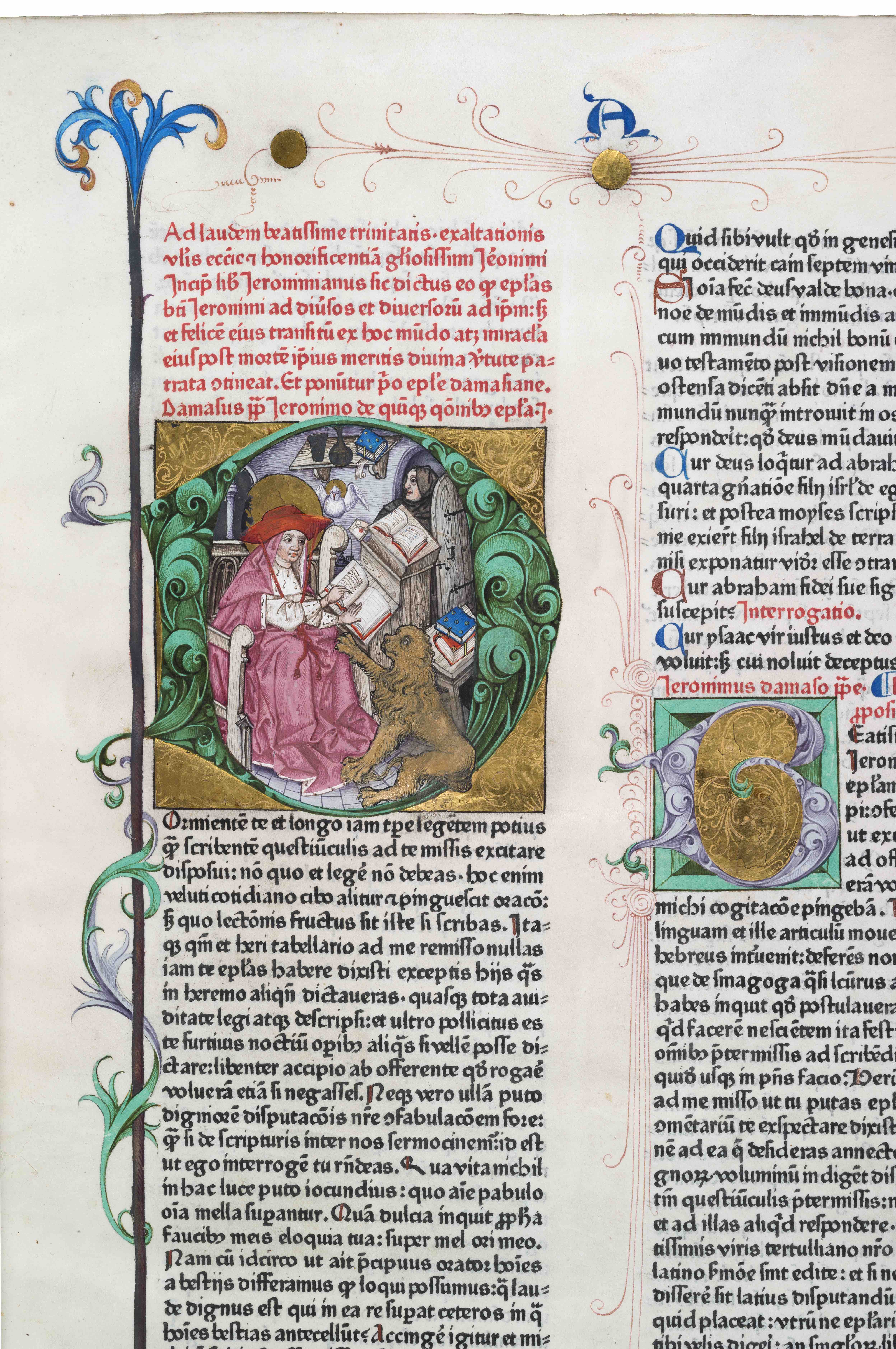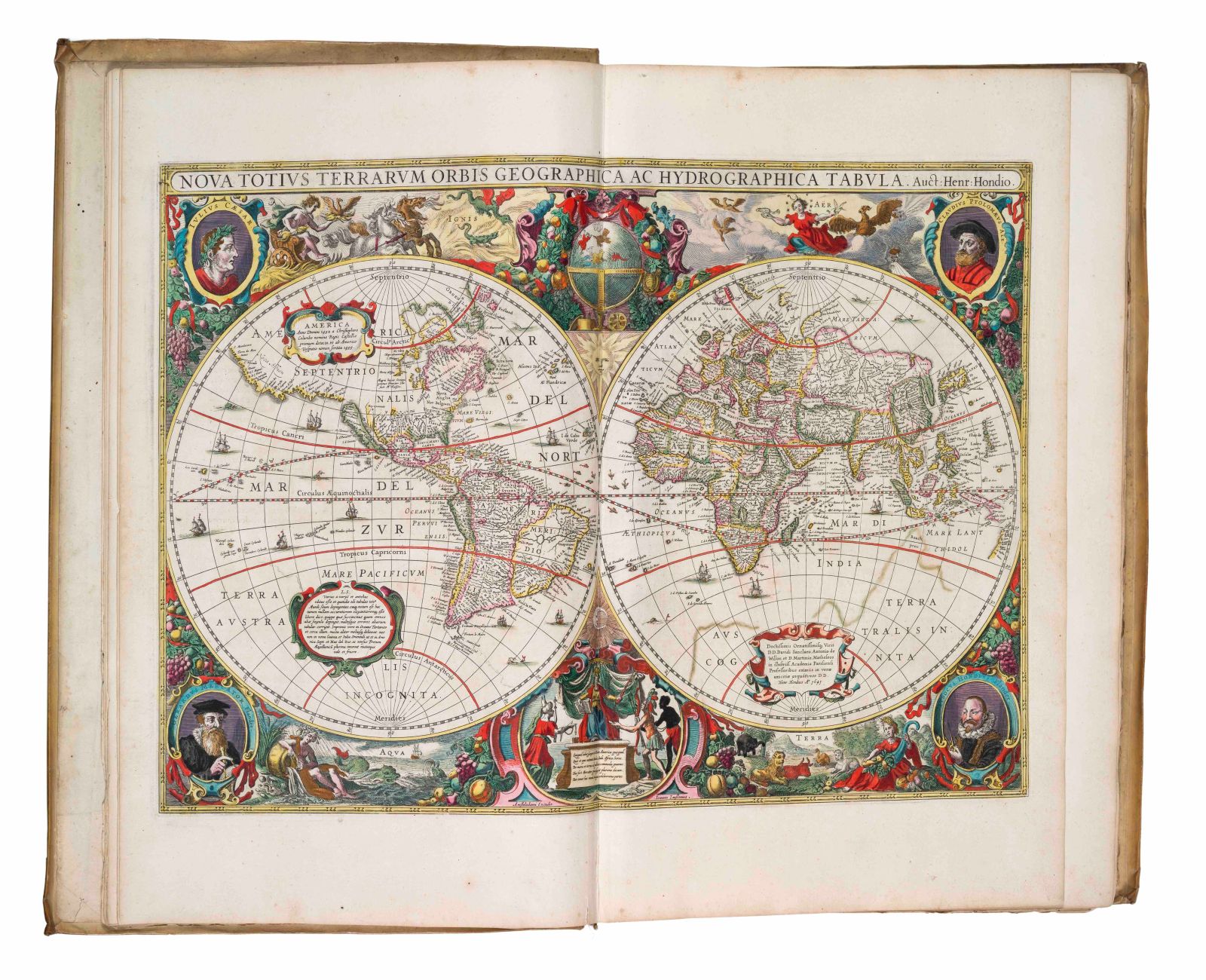OVA - ORIGIN(S) • MEDIEVAL AND RENAISSANCE WORKS
Saturday 16 June 2018
Experts : Ariane Adeline, Thierry Bodin, Jacques Benelli

The series of sales will begin with “Origin(s)” • Medieval and Renaissance Works offered by Aguttes. Forty-five charters, manuscripts, incunabula and printed works from medieval times to great Renaissance discoveries are grouped together in a sale with a total estimate of €4.5 million. The charters and documents cover part of France’s history, from the charter in favour of the Abbey of Corbie dated August 825 to a letter from Marie de’ MEDICI (1575-1642) to her aunt in 1622. Also included is a letter from Jean II LE BON (1319-1364) to his son while he was a captive in England, letters from Louis XII (1462-1515), François I (1494-1547) and his sister Marguerite D’ANGOULÊME, Queen of Navarre (1492-1549), Henri II (1519-1559), one from Henri IV (1553-1610) to Pope Paul V, and a letter written by Charles IX (1550-1574).
[LUCE DE GAT; HELIE DE BORON (ATTRIBUTED TO)]. [TRISTAN ET ISEULT (TRISTAN IN PROSE)].
GREAT HOURS OF GALEAZZO MARIA SFORZA: BOOK OF HOURS, ACCORDING TO THE ROMAN RITE
The manuscript of the Great Hours of Galeazzo Maria Sforza, in Latin and Italian, illuminated on parchment in Milan in around 1471-1476, is another masterpiece of the sale (estimate: €600,000-800,000). It was copied and illuminated for Galeazzo Maria Sforza. First Count of Pavia, then Duke of Milan, he was born in Fermo (Marches region) on 24 January 1444 and died in Milan on 26 December 1476. He was the son of Cosimo de’ Medici’s ally François Sforza (d. 1466) and Bianca Maria Visconti. He first married the daughter of Ludovico III of Mantua, Dorotea Gonzaga (1449-1467), who died in Pavia the following year on 24 April 1467. The following year, he married his second wife, Bona of Savoy (1449-1485), daughter of Louis I, Duke of Savoy, and Anne of Lusignan. After a chequered rule marked by his love of the arts and his cruel, tyrannical and lecherous behaviour, Galeazzo was assassinated on 26 December 1476 in the church of Santo Stefano, Milan. This Book of Hours is a monument to the glory of the Duke of Milan: the prince’s emblems are almost as prominent as the those of the religious subjects in the dropped initials. Of an exceptional size, almost as large as the Grandes Heures du Duc de Berry (each bi-folio required an entire goatskin), the manuscript could have been used with a lectern in a princely chapel. The historiated initials are by the hand of a very subtle Milanese artist, known as the Master of Ippolita Sforza, active in Lombardy from 1450 to 1475. His name comes from the manuscripts he illuminated for Galeazzo Maria’s sister, Ippolita Sforza, notably for her marriage to Alfonso of Aragon, Duke of Calabria, in 1465.
THE “PETAU” HOURS: BOOK OF HOURS ACCORDING TO THE ROMAN RITE
Leading the auction is the so-called “Petau” Book of Hours, estimated between €700,000 and €900,000. It is named after the Petau family [Paul Petau (1568-1614) or Alexandre Petau (1610-1672)], an owner identified by the painted coat of arms, added in the 17th century. The Petaus were major books and archives collectors, who opened the doors of their library to 17th-century scholars. Some, like Jacques Sirmond and André Duchesne, even published some texts they found there. The manuscripts of this library (known as the Petaviani) were acquired between 1590 and 1659 (when the acquisition date is known). Alexandre Petau possessed more than 1,800 works in 1650. The same year, he sold nearly 1,500 of them to Queen Christina of Sweden. On her death, her collection was transmitted to the Vatican library, which now contains a large number of the volumes once belonging to the Petaus. At the end of his life, Alexandre Petau owned a small collection of approximately 300 manuscripts and incunabula, which were gradually sold. In the 18th century, it seems that the Petau Book of Hours belonged to the Van Vooghts of Bruges before joining the collection of Baron James de Rothschild, who had it bound with his arms.Decorated and written in Latin on parchment, the book evinces extraordinary skill in the page layout. The 16 medallions in gold monochrome are the work of Jean POYER, a Touraine artist active between 1490 and 1520, whose patrons included Anne of Brittany and her two royal husbands, Charles VIII and Louis XII. The presentation of these medallions with biblical scenes or figures is exceptional. Jean Poyer designed them in pairs (on both sides) at the beginning and end of each section in the various liturgical divisions. The inserted pages are hollowed out in the centre, so that viewers can admire the gold monochromes while reading the text that goes with them.
MONTAIGNE (MICHEL DE), Essais de Messire Seigneur de Montaigne

One of the manuscripts, Tristan et Iseult, attributed to Luce DE GAT and Hélie DE BORON, is particularly remarkable (estimate: €250,000-350,000). The romance was written on paper in French, probably in Bruges in around 1470-1475, and given to a prince of the court of Burgundy (Simon or Josse de Lalaing). The manuscript is illustrated with a large illuminated frontispiece showing several scenes in a single tableau. We see Tristan mounting a horse. On the left, Tristan welcomes Iseult arriving by boat. Lastly, in a distant forest, Iseult is sitting on the ground, watching Tristan battle with a wild boar. The miniature can be attributed to Loyset LIÉDET (active from 1454) or to his studio. He appeared in 1469 as one of the new members of the Guild of the Book Workers of the City of Bruges and worked mainly for the court of Burgundy, particularly for Duke Charles the Bold, for whom he produced over 400 miniatures.
GREAT HOURS OF GALEAZZO MARIA SFORZA: BOOK OF HOURS, ACCORDING TO THE ROMAN RITE
.jpg) | aaa |
THE “PETAU” HOURS: BOOK OF HOURS ACCORDING TO THE ROMAN RITE
.jpg) | aaa |
 | aaa |
SAINT JEROME, EPISTOLAE [LETTERS], PRINTED BY ADRIANUS BRIELIS (d. 1472)MAINZ: PETER SCHOEFFER, 7 SEPTEMBER 1470
The incunabula include the first edition of the Epistolary of St Jerome (estimate: €600,000-800,000). These documents were printed and annotated during the very first decades of printing: there are four extant editions of St Jerome’s Letters dating from 1468 to 1470, containing between 70 and 130 letters. The edition presented in the sale, in a new version by Peter SCHOEFFER, contains over 200 epistles organised by theme. Schoeffer made a considerable effort to seek out unpublished letters in ecclesiastical and monastic libraries. The book has hand-painted decoration typical of the illumination work produced in Mainz (Germany). More precisely, artists who worked for these volumes were directly linked with Peter Schoeffer’s printworks in Mainz. The decoration opens with a 16-line high historiated initial showing St Jerome in his studiolo, acting as a “frontispiece page”. The initial is extended by a decorated border with archers chasing a dragon. In addition to this decoration we find several 8-line high painted, embellished initials, each introducing “Distinctions”. When Peter Schoeffer designed his edition, he proposed versions on paper or vellum, with and without decorations, with ornaments ranging from simple filigree to historiated illumination. This so-called “Doheny” copy is one of the most luxurious books ever published by Schoeffer’s print works..
The incunabula include the first edition of the Epistolary of St Jerome (estimate: €600,000-800,000). These documents were printed and annotated during the very first decades of printing: there are four extant editions of St Jerome’s Letters dating from 1468 to 1470, containing between 70 and 130 letters. The edition presented in the sale, in a new version by Peter SCHOEFFER, contains over 200 epistles organised by theme. Schoeffer made a considerable effort to seek out unpublished letters in ecclesiastical and monastic libraries. The book has hand-painted decoration typical of the illumination work produced in Mainz (Germany). More precisely, artists who worked for these volumes were directly linked with Peter Schoeffer’s printworks in Mainz. The decoration opens with a 16-line high historiated initial showing St Jerome in his studiolo, acting as a “frontispiece page”. The initial is extended by a decorated border with archers chasing a dragon. In addition to this decoration we find several 8-line high painted, embellished initials, each introducing “Distinctions”. When Peter Schoeffer designed his edition, he proposed versions on paper or vellum, with and without decorations, with ornaments ranging from simple filigree to historiated illumination. This so-called “Doheny” copy is one of the most luxurious books ever published by Schoeffer’s print works..
MONTAIGNE (MICHEL DE), Essais de Messire Seigneur de Montaigne
 | aaa |
Last but not least, printed works include a first edition of the first two books of Essais by Michel de MONTAIGNE (1533-1592) (estimate: €100,000-150,000). Montaigne and the publisher, Simon Millanges, shared the publication costs. The copies that went to the publisher were sold, while the author distributed his share to his close circle. Montaigne published a second edition of his book in 1582. Enriched with several quotes, this also took account of Rome’s censorship, and contained an extra passage accepting the Church’s condemnation in advance at the beginning of the chapter “Des Prières”..
JANSSONIUS (JOHANNES), New Atlas or Theatre of the World including tables and descriptions of all regions of the universal world.
Ending the sale are six volumes of the New Atlas or Theatre of the World containing tables and descriptions of all regions of the universal world, conceived by JANSSONIUS (JOHANNES) (1588-1664) take viewers on a journey through maps dated 1652, 1656 and 1657 (estimate: €100,000-150,000). This is one of the treasures of the golden century of Netherlands mapmaking; it is complete, in its publisher’s gilt vellum binding, and may have belonged to Montesquieu. The “New Atlas” was the work of several generations of cartographers: Mercator, Ortelius and Jodocus Hondius.
JANSSONIUS (JOHANNES), New Atlas or Theatre of the World including tables and descriptions of all regions of the universal world.
 |
Ending the sale are six volumes of the New Atlas or Theatre of the World containing tables and descriptions of all regions of the universal world, conceived by JANSSONIUS (JOHANNES) (1588-1664) take viewers on a journey through maps dated 1652, 1656 and 1657 (estimate: €100,000-150,000). This is one of the treasures of the golden century of Netherlands mapmaking; it is complete, in its publisher’s gilt vellum binding, and may have belonged to Montesquieu. The “New Atlas” was the work of several generations of cartographers: Mercator, Ortelius and Jodocus Hondius.
This sale, n° 2, is organised by Aguttes
Total number of lots: 45
Global estimate: €4,500,000
Public auction – Drouot – Room 9
Saturday 16 June 2018 – 2:30pm
Public exhibition – Drouot – Room 9
Thuesday 12 June – 11am – 6pm
Wednesday 13 June – 11am – 6pm
Thursday 14 June - 11am – 9pm
Friday 15 June – 11am – 6pm
Saturday 16 June - 11am - 12pm

Total number of lots: 45
Global estimate: €4,500,000
Public auction – Drouot – Room 9
Saturday 16 June 2018 – 2:30pm
Public exhibition – Drouot – Room 9
Thuesday 12 June – 11am – 6pm
Wednesday 13 June – 11am – 6pm
Thursday 14 June - 11am – 9pm
Friday 15 June – 11am – 6pm
Saturday 16 June - 11am - 12pm

